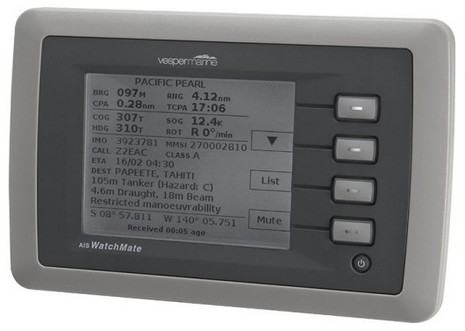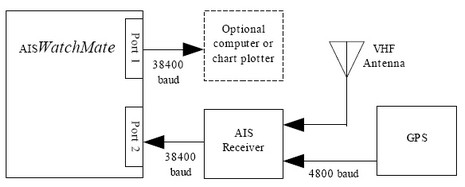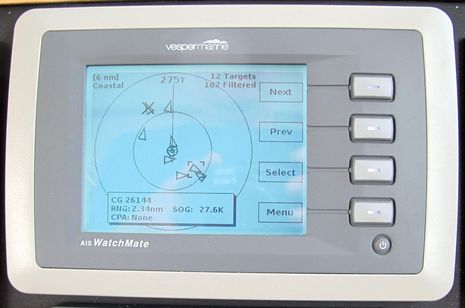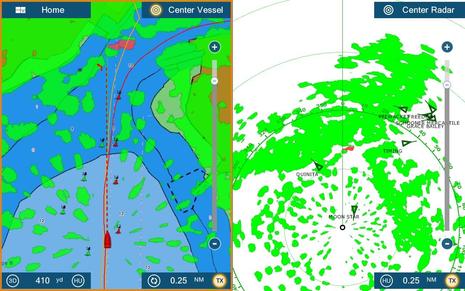Vesper AIS WatchMate, smart details

Milltech Marine is carrying a new AIS display of particular interest to power-sensitive offshore sailors. The Vesper Marine AIS WatchMate has a 5–inch “daylight readable” monochrome screen, but purportedly only draws 1.2 watts average, 2.5 max. The $499 unit is not a receiver and does not do graphic target plotting, but I read through the preliminary manual and was impressed by how thoroughly the designers—who are offshore sailors—thought out the details of collision avoidance. For instance, WatchMate not only has range and CPA/TCPA alarms with sophisticated filtering, but also supports four “profiles” so you can easily switch setups in different conditions like “offshore” or “coastal”. It strikes me that WatchMate would also work well with a Class B transponder, though of course you’d still need a PC connection to set it up and, sigh, you can’t buy one in the U.S. yet. Note, too, that those NMEA 0183 ports shown below are actually wires in a single cable, and should be fairly easy to install in a waterproof way, plus there are several other possible install configurations. Hopefully Milltech or Vesper will make the manual available soon. 














Hi Ben, I am sure you knew this question would come… 🙂 … is this not similar to the NASA Marine Radar? The Nasa contains all this in one box and for less money.
I don’t think it’s that similar, SeaJet. For instance, it’s my understanding that the NASA “radar” unit will not output AIS to a PC or Plotter, which would be a deal breaker for me, and I’d bet that at least the older ones don’t even see Class B targets.
NASA cuts too many corners for my taste. I very much doubt they’ve thought out AIS alarming the way Vesper has, but it’s hard to tell as they don’t seem to offer much in the way of specs or an online manual. If you know where those are, please post links.
Ben, you are correct in that the Nasa AIS Radar does not output data at all. What you see is what you get, on the built in grayscale screen.
I looked for specs. There is no online manual. The best I can come-up with is on this page http://www.allgadgets.co.uk/ag/product.asp?dept%5Fid=110&pf%5Fid=AG3928
I was wrong. There is an online copy of the Nasa Marina AIS Radar. You can find it here http://www.allgadgets.co.uk/ag/Assets/pdfs/AISRAD1.pdf
Thanks, Seajet! But now I remember more reasons I never liked this display. AIS can be easily used to compute CPA and TCPA with better accuracy than even a big ship’s ARPA radar. But the Nasa “Radar” does not compute those values, instead reducing the AIS info to an old time relative motion radar plot, especially tricky to intrepret if you change course or speed.
Moreover, the only alarm Nasa provides is range. The result is that you could get alarmed for an anchored boat, as long as it was inside the inner ring of whatever range you were on. But a vessel just outside that ring would not set off the alarm even if it was speeding toward a zero Closest Point of Approach with you.
I think there’s a good reason that no plotter or charting software displays AIS targets like this display does. But it’s better than nothing 😉
Is there really a market for something like this? I know laptops draw considerably more power than this device, but you also get alot more bang per watt from them (plotting for instance!).
And $499 seems high for something that could be implemented with a relatively small embedded processor and LCD display.
Brian
I’ve dabbled with AIS on board my sailboat using a combination of Milltech’s SR161 receiver, a laptop, and Navsim’s charting software. I’m absolutely convinced AIS has an important role in vessel safety for both the professional and leisure mariner.
Brian has a point in terms of the additional functionality delivered by the laptop. But, there is a huge penalty in terms of electrical consumption.
Based on this device’s specs, I could run it for a month on the electricity my laptop would use in a day. To me, there are times when that’s an important (overwhelming???) consideration.
In coastal cruising, the additional capabilities in the laptop, notably plotting, are eminently useful and well worth the electrical drain. Especially when it’s relatively easy to replenish.
However, it seems to me that when offshore, plotting is practically irrelevant while the CPA and TCPA alarms combined with very low power usage would make this device the gadget of choice. It provides immediate access to all the information needed to contact directly the other vessel.
For the offshore sailor, one of the biggest advantages of this unit has not been mentioned: Alarms. It’s common for cruising sailboats to be undermanned, or even single-handed. There’s not even enough time to make coffee safely. Or sleep.
This unit has many ways to set off an external 12 V DC alarm, so you don’t have to watch the display continually.
So this is really a replacement for a radar detector. You can use it in addition to displaying AIS data in other ways, but for offshore this may be enough.
Thanks Ben for writing about the AIS WatchMate. When we designed the AIS WatchMate we focussed on collision avoidance rather than position plotting or radar simulation. Our goal is to provide an easy to use collision alarm and AIS display that is capable of handling large numbers of targets. One issue with plotted or radar displays when there are many targets is which target does the user focus their attention to. As you’ve pointed out, the nearest ones are not necessarily the highest risk.
We’ve sailed across the Pacific with it and found it to be very helpful both in high traffic areas and also when a lone ship appears on the horizon. But we’ve also found it to be quite useful inshore as well. As William points out, you often have plenty of power available in that situation. But a dedicated and uncluttered AIS display and alarm has still proven quite useful to us.
Computers are quite useful too of course, but their complexity, reliability, and power consumption may be an issue for some.
As Norse notes, short-handed crews are finding the AIS WatchMate to be especially useful. Each alarm profile can be fine tuned to meet your needs so they have lots of control over when they wish to be notified.
We don’t have a downloadable manual because our customers told us the manual we had originally produced was too dense and most wouldn’t read it. So we now send the units out with a short Quick Start guide explaining how to hook it up and briefly it’s capabilities. I’d be happy to make that available if anyone wants it.
Jeff Robbins
Vesper Marine
Thanks for posting here, Jeff, but I would highly encourage you to ship both the original manual and the quick start guide with the product, and also to make both available for download. If you look at the home sites of Raymarine, Furuno, Garmin, Simrad, Lowrance, etc. you’ll see that they all provide both types of publications to their users, and also give them away in PDF form to prospective buyers. Many of us find them very helpful for evaluating a product.
I notice that on the Vesper web site it says:
In New Zealand, all AISWatchMate’s include the AIS receiver.
Having an AIS receiver included in the unit would be a much more compelling reason to buy one from both a $$$ and power budget point of view.
It would also have the added feature of MUXing the GPS and AIS onto one serial output for connection to the PC or chartplotter.
I wonder if we can (or why we can’t) buy the New Zealand version?
Chris: I was curious about this myself and checked the NZ dealers listed on the Vesper Marine web site. I think this product is so new (went public in March?), that none of the dealers has any information about AISWatchMate on their web sites. I would be interested to see how the NZ price compares to the US price. Especially, when the NZ delivery comes with the AIS receiver.
Sorry for the confusion. In New Zealand we bundle an AIS receiver with the units to make it easier for our customers to purchase and install.
Chris: The AIS WatchMate does provide the ability to combine its inputs into a single output stream so you can use only one serial port on your computer.
Ben: I’ve posted the quick start and wiring diagrams on our website. I’m working on the user’s manual and will post it when it’s ready.
Thanks for the comments and suggestions.
Jeff
Vesper Marine
I finally got an answer from the FCC to my Congressional Inquiry. It said “stone wall.” However, I greatly admire a really good stone wall, and this one is first class: Watermarked Stationary, FCC letterhead, offset. Human signature in blue ink. The Author artfully redirects the original question in a totally innocuous direction, and closes with friendly plattitudes cloaking a single disturbing clue: “In 2006, the Commission sought comment on standards for certifying Class B AIS shipborne equipment, and further measures the Commission might adopt to ensure the accuracy of data transmitted from such devices.” This raises a chilling question. How did it become the FCC’s responsibility to do so when an accepted and functional World standard exists? Are they delaying the availability of a life-saving device to make sure the T’s are crossed and the I’s are dotted? And isn’t the US a signatory in the agreement that created that standards organization?
We’re long term/long range cruisers and the AIS Watchmate sounds like a great thing for us. However, as we sit here in San Francisco I’ve been watching AIS traffic on the web. Some vessels that seem to report their positions correctly are sending out bogus course and speed fields. With a graphical plotter one could work the plot just like a PPI on a radar. Does the Watchmate use consecutive position reports to determine target motion or is it dependent on reported course and speed? Is there any error checking?
Just finished coming up to Newport from the Caribbean, and the AIS was a big help offshore, but I needed to leave the laptop on, and there was no sorting of the targets by CPA. The watchmate, with low power needs and alarms, seems like a plus, but what I really want is a class B transponder box which incorporates the watchmate alarm system.
The other issue I have with the current displays, (and what I see of watchmate seems no different), is the issue of crossing situations. OK, I’m crossing a ship and the CPA is 0.5 miles, but who is crossing ahead?? The only way I have of telling right now is to bear left or right for a while and see what happens to the CPA, but the answer should be readily available with a bit more programing–perhaps the display could tell me whether going left or right, or slower or faster, will increase the CPA.
Don makes a good point. First the warning that there is a problem, then a different display to help solve it. The Panbo item for 6 Dec 2007 has a screenshot of some software that shows the danger area for a ship. Here is a case where the graphic gives much more information than a table of numbers and in just a glance too. See also:
http://yachtvalhalla.net/adventures/aisklang/aisklang.htm
I’d like an alarm for when the ship changes course.
An update on the AIS WatchMate… we’ve got a new version with a graphical radar-like situation display. It provides a heading-up display showing the relative positions of the targets with their courses indicated by the direction of their ship “icon”. It also indicates dangerous targets, nav aids and lost targets. It has a popup box for quick info on any given target. You can get a look at some screen shots on our website: http://www.vespermarine.com
A unique new feature is an additional graphical display showing the crossing situation for a target. It displays the relative positions of your vessel and the target at CPA. This visually indicates if a target will cross ahead or behind you. It’s constantly updated so as you change course or speed you can easily see how it affects the situation.
We’ve been finding that the WatchMate works very well in conjunction with Class B transponders. It also has new features for monitoring the transponder and reporting transponder errors such as transmitter failures. It does this by sounding the alarm and popping up a window describing the problem.
Of course, all the other alarm, filtering and target prioritisation features remain.
All WatchMates may be upgraded to this new version. Owner’s can do this themselves by downloading the upgrade from our website and connecting the WatchMate to their PC. The upgrade will be posted to our website in the next few days.
Jeff Robbins
Vesper Marine